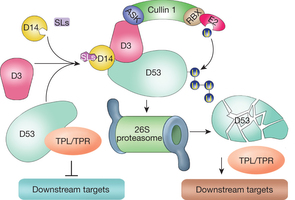Nature:中国证实D53可抑制独脚金内酯信号途径调控植物分枝生长
一项研究首次在遗传和生化层面证实,蛋白D53可通过抑制独脚金内酯信号途径调控植物分枝(蘖)的生长发育。中国农业科学院作物科学研究所万建民课题组与南京农业大学作物遗传与种质改良国家重点实验室合作完成。相关文章发表于2013年12月11日于的《Nature》杂志上。


Nature:中国证实D53可抑制独脚金内酯信号途径调控植物分枝生长发育
万建民课题组利用一个部分显性水稻矮化多分蘖突变体进行了外源激素处理和内源激素测定。
结果表明,d53是一个独脚金内酯不敏感突变体。通过精细定位和图位克隆,他们获得了位于水稻第11号染色体短臂末端的DWARF53(D53)基因,该基因编码一个新的在结构上与I类Clp ATPase类似的核蛋白。
后续的功能分析发现,在独脚金内酯存在的条件下D53蛋白可与两个已知的独脚金内酯信号分子D14、D3互作形成蛋白复合体,进而使得泛素化的D53蛋白特异地被蛋白酶体系统降解,从而诱导下游目标基因的表达以及独脚金内酯信号的响应。
业内专家认为,该研究不仅为植物,特别是农作物的株型改良提供了重要的理论基础,同时也为水稻籼粳交杂种优势利用提供了有价值的基因和育种材料,并为籼粳交杂种优势在生产上的有效利用提供了应用前景。
原文摘要:
DWARF 53 acts as a repressor of strigolactone signalling in rice
Liang Jiang, Xue Liu, Guosheng Xiong, Huihui Liu, Fulu Chen, Lei Wang, Xiangbing Meng,Guifu Liu, Hong Yu, Yundong Yuan, Wei Yi, Lihua Zhao, Honglei Ma, Yuanzheng He,Zhongshan Wu, Karsten Melcher, Qian Qian, H. eric Xu, Yonghong Wang & Jiayang Li
Strigolactones (SLs) are a group of newly identified plant hormones that control plant shoot branching. SL signalling requires the hormone-dependent interaction of DWARF 14 (D14), a probable candidate SL receptor, with DWARF 3 (D3), an F-box component of the Skp–Cullin–F-box (SCF) E3 ubiquitin ligase complex. Here we report the characterization of a dominant SL-insensitive rice (Oryza sativa) mutant dwarf 53 (d53) and the cloning of D53, which encodes a substrate of the SCFD3 ubiquitination complex and functions as a repressor of SL signalling. Treatments with GR24, a synthetic SL analogue, cause D53 degradation via the proteasome in a manner that requires D14 and the SCFD3 ubiquitin ligase, whereas the dominant form of D53 is resistant to SL-mediated degradation. Moreover, D53 can interact with transcriptional co-repressors known as TOPLESS-RELATED PROTEINS. Our results suggest a model of SL signalling that involves SL-dependent degradation of the D53 repressor mediated by the D14–D3 complex.
D14–SCFD3-dependent degradation of D53 regulates strigolactone signalling
Feng Zhou, Qibing Lin, Lihong Zhu, Yulong Ren, Kunneng Zhou, Nitzan Shabek, Fuqing Wu, Haibin Mao, Wei Dong, Lu Gan, Weiwei Ma, He Gao, Jun Chen, Chao Yang, Dan Wang,Junjie Tan, Xin Zhang, Xiuping Guo, Jiulin Wang, Ling Jiang, Xi Liu, Weiqi Chen, Jinfang Chu, Cunyu Yan, Kotomi Ueno, Shinsaku Ito, Tadao Asami, Zhijun Cheng, Jie Wang, Cailin Lei, Huqu Zhai, Chuanyin Wu, Haiyang Wang, Ning Zheng & Jianmin Wan
Strigolactones (SLs), a newly discovered class of carotenoid-derived phytohormones, are essential for developmental processes that shape plant architecture and interactions with parasitic weeds and symbiotic arbuscular mycorrhizal fungi. Despite the rapid progress in elucidating the SL biosynthetic pathway, the perception and signalling mechanisms of SL remain poorly understood. Here we show that DWARF 53 (D53) acts as a repressor of SL signalling and that SLs induce its degradation. We find that the rice (Oryza sativa) d53 mutant, which produces an exaggerated number of tillers compared to wild-type plants, is caused by a gain-of-function mutation and is insensitive to exogenous SL treatment. The D53 gene product shares predicted features with the class I Clp ATPase proteins and can form a complex with the α/β hydrolase protein DWARF 14 (D14) and the F-box protein DWARF 3 (D3), two previously identified signalling components potentially responsible for SL perception. We demonstrate that, in a D14- and D3-dependent manner, SLs induce D53 degradation by the proteasome and abrogate its activity in promoting axillary bud outgrowth. Our combined genetic and biochemical data reveal that D53 acts as a repressor of the SL signalling pathway, whose hormone-induced degradation represents a key molecular link between SL perception and responses.

